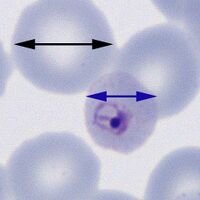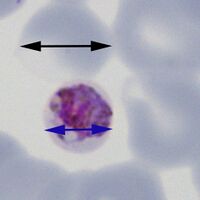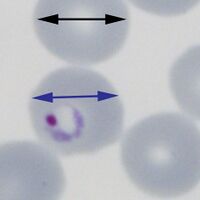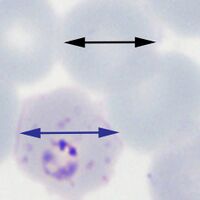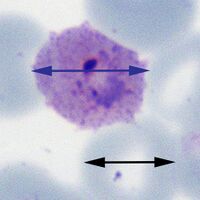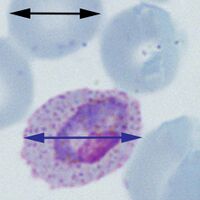Red cell size: Difference between revisions
From haematologyetc.co.uk
No edit summary |
No edit summary |
||
| Line 48: | Line 48: | ||
For both ''P.ovale'' and ''P.vivax'' the red cells become progressively enlarged and distorted as the parasites develop. It may not be possible to distingish the species based on red cell appearances, but there are differences which should be looked for. | For both ''P.ovale'' and ''P.vivax'' the red cells become progressively enlarged and distorted as the parasites develop. It may not be possible to distingish the species based on red cell appearances, but there are differences which should be looked for. | ||
''P.ovale:'' | ''P.ovale:'' | ||
Expect increased red cell size but this may not be marked; the typical shape is an ovoid shape (hence the name) and there may be characteristic finbriation of cytoplams (that may be limited to one pole of the cell). | |||
<gallery mode="nolines" widths="200px" heights="220px" > | <gallery mode="nolines" widths="200px" heights="220px" > | ||
File: | File:5SizePOET.jpg|A|link={{filepath:|5SizePOET.jpg}} | ||
File: | File:6SizePOLT.jpg|B|link={{filepath:4SizePOLT.jpg}} | ||
</gallery> | </gallery> | ||
'' | ''T.'' | ||
---- | ---- | ||
Revision as of 21:59, 24 March 2024
Navigation
Go Back
| How is red cell size and shape affected as malaria develops?
SMALL ROUND RED CELLS P.malariae: The red cells in this species remain round and are often small in size The early (A) and late trophozoites (B) shown in this image each lie within round erythrocytes with reduced size.
RED CELLS WITH UNCHANGED SIZE AND SHAPE P.falciparum (and P.knowlesi) Red cell size and shape is generally unchanged although they may become crenated
The early (A) trophozoites lie within red cells that do not change size or shape, at later development (B) they may remain unchanged or acquire subtle crenation.
ENLARGED AND DISTORTED RED CELLS For both P.ovale and P.vivax the red cells become progressively enlarged and distorted as the parasites develop. It may not be possible to distingish the species based on red cell appearances, but there are differences which should be looked for.
Expect increased red cell size but this may not be marked; the typical shape is an ovoid shape (hence the name) and there may be characteristic finbriation of cytoplams (that may be limited to one pole of the cell).
T. P.vivax
|
